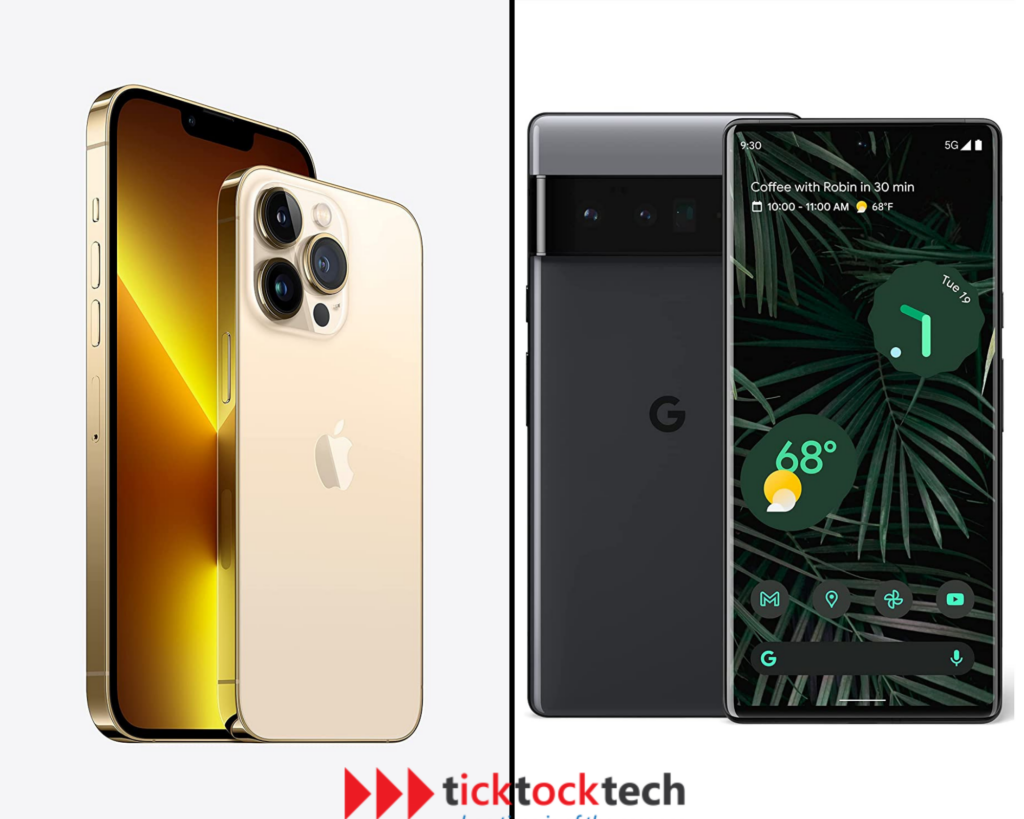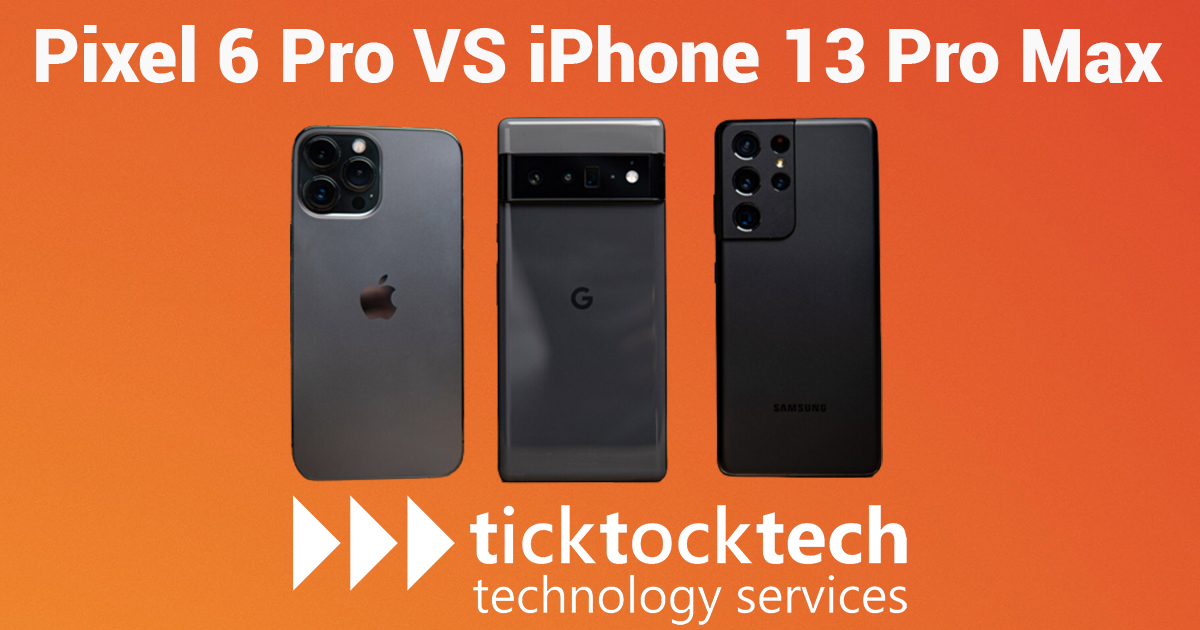Picking a smartphone of your choice sometimes might be confusing, especially when you have to choose between two top-rated phones. There are many different smartphone producers from different countries which serve a purpose in modern technology. Talking the most popular ones like iPhone, Samsung, OnePlus, Xiaomi, Pixels, etc. do have similar functionalities sometimes. However, there’s always a loophole to their specification difference, in all, your purpose of buying and budget matters. Let’s take a look at the newest available (in use as of July 2022) of these two brands: The Google Pixel and Apple iPhone which is the Pixel 6 Pro and iPhone 13 pro max. What are their specifications? Compares? And which should you get? You’re about to find out a satisfying answer to this.
Pixel 6 Pro Vs iPhone 13 Pro Max: Specifications
| Features | iPhone 13 Pro Max | Google Pixel 6 Pro |
| Design | Stainless steel frame, Gorilla Glass screen, and glass back in the dimensions of 160.8 x 78.1 x 7.7 mm (6.7 inches, 109.8 cm2 (~87.4% screen-to-body ratio). It weighs 240g and has an IP68 rating for dust and water resistance, with a 6-meter working depth of 30-mins. Supports both single and dual SIM cards (eSIM and/or nano-SIM) | Aluminum frame with dimensions of 163.9 x 75.9 x 8.9 mm (6.71 inches, 110.5 cm2 (~88.8% screen-to-body ratio), weighing 210g (lightweight), Gorilla victus front screen, and glass back. Additionally, it has IP68 dust/water resistance and can withstand 1.5m of water for 30 minutes (Not as deep as for iPhone). Single eSIM or Nano-SIM. |
| Memory storage | Comes in 3 models with 128GB ROM 6GB RAM; 256GB ROM 6GB RAM; 512GB ROM 6GB RAM; 1TB ROM 6GB RAM (NVMe type) | Also comes in 3 models 128GB ROM12GB RAM, 256GB ROM12GB RAM, 512GB ROM 12GB RAM (Type UFS 3.1) |
| Processors | Operates on iOS 15 and can be upgraded to the new iOS 16. CPU processed by the latest Apple A15 Bionic (5 nm) Hexa-core (2×3.23 GHz Avalanche + 4×1.82 GHz Blizzard) and Apple 5-core graphics GPU (currently fastest in all smartphones) | Octa-core processors with the Tensor (5 nm) chipset (2×2.80 GHz Cortex-X1, 2×2.25 GHz Cortex-A76, and 4×1.80 GHz Cortex-A55) perform CPU operations. The operating system is powered by Google’s Android 12. Mali-G78 MP20 GPU |
| Display | OLED display with 120Hz refresh rate and Super Retina resolution. 19.5:9 contrast ratio and 1284 x 2778-pixel HDR10 screen resolution. The brightness of 1000 nits (HBM), with 1200 nits (peak). Ceramic glass with an oleophobic layer that resists scratches. | LTPO AMOLED display, also with 120Hz refreshing rate. HDR10+ screen resolution 1440 x 3120 pixels, and 19.5:9 contrast ratio. 500 nits (HBM) brightness, with 800 nits (peak). Corning Gorilla Glass Victus scratch protection ability. |
| Camera and Video | Back/Main 3 Camera Lenses: Lens 1: 12 MP, f/1.5, 26mm (wide), 1.9µm, dual pixel PDAF, sensor-shift OIS Lens 2: 12 MP, f/2.8, 77mm (telephoto) 3x optical zoom Lens 3: 12 MP, f/1.8, 13mm, 120˚ (ultrawide) (with Dual-LED dual-tone flash, HDR (photo/panorama) Video Quality 4K@24/30/60fps, 1080p@30/60/120/240fps, 10-bit HDR (up to 60fps) Front Camera: 12 MP, f/2.2, 23mm (wide) with (depth/biometrics sensor) and video quality 4K@24/25/30/60fps, 1080p@30/60/120fps | 3 differently sized back camera Big Lens: 50 MP, f/1.9, 25mm (wide), 1/1.31″, 1.2µm, Dual Pixel PDAF Middle Lens: 48 MP, f/3.5, 104mm (telephoto), 1/2″, 0.8µm, PDAF 4x optical zoom Small Lens: 12 MP, f/2.2, 17mm, 114˚ (ultrawide), 1.25µm Video Quality 4K@30/60fps, 1080p@30/60/120/240fps Front Camera: 1.1 MP, f/2.2, 20mm (ultrawide), 1.22µm and video quality HDR 4K@30fps, 1080p@30/60fps |
| Battery | Li-Ion 4352 mAh, non-removable (16.75 Wh) with 121h endurance rating. Fast charging USB Power Delivery and MagSafe wireless charging 15W 2.0 Also supports Qi magnetic fast wireless charging 7.5W | Li-Ion 5003 mAh, non-removable with 84h endurance rating. Fast charging USB Power Delivery and Reverse wireless charging 2.0. Also supports fast wireless charging 23W |
| Connectivity | Wi-Fi 802.11 v6, dual-band, hotspot. Bluetooth version 5.0 Lightning, USB port 2.0, A-GPS, and no audio jack. | Supports Wi-Fi 802.11 v6e, dual-band, Wi-Fi Direct, hotspot. Bluetooth version 5.2 and dual-band A-GPS, one port of USB Type-C 3.1, and no audio jack. |
| Other Important Features | Face ID, accelerometer, gyro, proximity, compass, barometer. | Fingerprint (under display, optical), accelerometer, gyro, proximity, compass, barometer |
Notable Differences

From the design, the google pixel 6 pro is slightly bigger in size but lighter in weight than the iphone13 pro max. This is due to its difference in both the metal type (aluminum, lighter than steel) and also the gorilla corning screen to body ratio as the former has a larger screen percentage. Another notable stuff about the design’s capability is the water resistance strength which the iPhone can last 30mins in 6m deep water, while the pixel is only 1.5m which means you can’t possibly use it deep in the ocean.
On the memory and storage, the pixel pro offers more RAM capacity for every of its memory size. However, this doesn’t mean it will be very much faster than the iPhone as they use different processors, and also, just like most android, the in-built app and OS might already be using up to a quarter of the RAM to run.
The apple A15 bionics is one of the best, or eventually the best in most of the mobile phone processors with optimized features, and you can learn more on why it beats most phone processors. With a larger screen and much better PPI, the pro 6 beats the iphone13 display resolution though it has a lower range of brightness.
Noticeably, the pixel pro battery seems higher in number than the iPhone but many tests show that placing both on the same screen time or operation time, the iPhone 13 pro max has a better battery optimization and lasts the almost same time as the pixel pro.
Pixel 6 Pro Vs iPhone 13 Pro Max: Which should you get?
Depends on both your budget and what part of the phone matters to you. The Pixel is cheaper, bigger, high screen resolution, and great camera and video quality. The iPhone on the other hand is also a great investment as it has a good long-term benefit as it will never get old until you decide to change it or apple decides to stop its update ( which could be like 8 – 10 years in the future).
The pixel pro doesn’t have updated durability and could be considered “old” when the next versions come out. In all you do, battery life matters, and not just for short periods but long periods. Apple has generally proved to be a great battery life optimizer and endurance capacity, both in the short and long run. This still applies to the 13 pros as it stays as long as even the pixel pro (with higher mah) and it also has long-time battery health features.
The Pixel 6 Pro starts at $899 and can go up to $1,099 for its 512GB of storage version. The iphone 13 pro max with 128GB, 256GB, and 512GB of internal storage goes for $799, $899, and $1,099 respectively.
If you have used either of them, let’s know in the comment session how they served your purpose.

